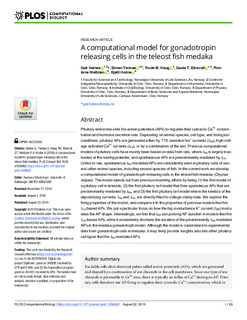| dc.contributor.author | Halnes, Geir | |
| dc.contributor.author | Tennøe, Simen | |
| dc.contributor.author | Haug, Trude | |
| dc.contributor.author | Einevoll, Gaute | |
| dc.contributor.author | Weltzien, Finn-Arne | |
| dc.contributor.author | Hodne, Kjetil | |
| dc.date.accessioned | 2019-09-13T07:37:48Z | |
| dc.date.available | 2019-09-13T07:37:48Z | |
| dc.date.created | 2019-08-28T19:47:42Z | |
| dc.date.issued | 2019 | |
| dc.identifier.citation | Plos Computational Biology, 2019 | nb_NO |
| dc.identifier.issn | 1553-734X | |
| dc.identifier.uri | http://hdl.handle.net/11250/2616699 | |
| dc.description.abstract | Pituitary endocrine cells fire action potentials (APs) to regulate their cytosolic Ca2+ concentration and hormone secretion rate. Depending on animal species, cell type, and biological conditions, pituitary APs are generated either by TTX-sensitive Na+ currents (INa), high-voltage activated Ca2+ currents (ICa), or by a combination of the two. Previous computational models of pituitary cells have mainly been based on data from rats, where INa is largely inactivated at the resting potential, and spontaneous APs are predominantly mediated by ICa. Unlike in rats, spontaneous INa-mediated APs are consistently seen in pituitary cells of several other animal species, including several species of fish. In the current work we develop a computational model of gonadotropin releasing cells in the teleost fish medaka (Oryzias latipes). The model stands out from previous modeling efforts by being (1) the first model of a pituitary cell in teleosts, (2) the first pituitary cell model that fires sponateous APs that are predominantly mediated by INa, and (3) the first pituitary cell model where the kinetics of the depolarizing currents, INa and ICa, are directly fitted to voltage-clamp data. We explore the firing properties of the model, and compare it to the properties of previous models that fire ICa-based APs. We put a particular focus on how the big conductance K+ current (IBK) modulates the AP shape. Interestingly, we find that IBK can prolong AP duration in models that fire ICa-based APs, while it consistently shortens the duration of the predominantly INa-mediated APs in the medaka gonadotroph model. Although the model is constrained to experimental data from gonadotroph cells in medaka, it may likely provide insights also into other pituitary cell types that fire INa-mediated APs. | nb_NO |
| dc.language.iso | eng | nb_NO |
| dc.rights | Attribution-NonCommercial-NoDerivatives 4.0 Internasjonal | * |
| dc.rights.uri | http://creativecommons.org/licenses/by-nc-nd/4.0/deed.no | * |
| dc.title | A computational model for gonadotropin releasing cells in the teleost fish medaka | nb_NO |
| dc.type | Journal article | nb_NO |
| dc.type | Peer reviewed | nb_NO |
| dc.description.version | publishedVersion | nb_NO |
| dc.source.volume | 15 | nb_NO |
| dc.source.journal | PloS Computational Biology | nb_NO |
| dc.source.issue | 8 | nb_NO |
| dc.identifier.doi | 10.1371/journal.pcbi.1006662 | |
| dc.identifier.cristin | 1719655 | |
| dc.relation.project | Norges forskningsråd: 248828 | nb_NO |
| dc.relation.project | Norges forskningsråd: 244461 | nb_NO |
| cristin.unitcode | 192,15,6,0 | |
| cristin.unitcode | 192,15,0,0 | |
| cristin.unitcode | 192,16,1,0 | |
| cristin.unitname | Seksjon for realfag og teknologi | |
| cristin.unitname | Realfag og teknologi | |
| cristin.unitname | Institutt for basalfag og akvamedisin | |
| cristin.ispublished | true | |
| cristin.fulltext | original | |
| cristin.qualitycode | 2 | |

